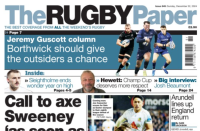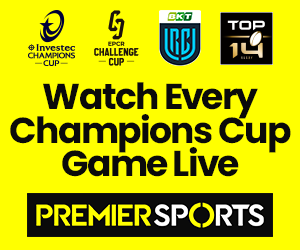 The Premiership has announced that it intends to increase the powers of the TMO’s at live televised games by allowing them to report foul play to the referee and, upon request, advise him of any reasons a try should not be awarded all the way back to the previous stoppage in play.
The Premiership has announced that it intends to increase the powers of the TMO’s at live televised games by allowing them to report foul play to the referee and, upon request, advise him of any reasons a try should not be awarded all the way back to the previous stoppage in play.
This makes a lot of sense to me, because I feel that to have the technology and not use it is as bad as being too reliant on it.
But to allow a referee to refer to the TMO for every decision would be a disaster for the continuity of what is supposed to be a dynamic and vibrant sport, particularly as they don’t always get it right, despite being able to freeze frame and see play from any number of angles.
There is also the time factor. How long after an incident could, or should, the TMO be allowed to report to the referee?
For instance, if at half-time the TMO reviews the first-half play and observes an act of foul play, will the player and his team be punished at the start of the second half?
At a try, how long will the TMO have to make his decision and will he be given all possible angles rather than the TV company later showing that a mistake was made from a previously unseen angle as has happened in the past?
The fact that the TMO is not allowed to identify an assailant, even if the referee has spotted an act of foul play but is unable to see which player was responsible, has always seemed a little odd to me, especially as the referees have the ability to ask citing officers to look at a particular incident.
This usually ends with an offending player having to face a disciplinary panel and a possible lengthy ban, so it would make better sense for both the player and his club if the referee were able to identify and punish him during the game.
That would help prevent cheating and have an immediate impact on the game that could change the end result which citing cannot do.
All this talk of assistance for match referees brings me back to my article a couple of weeks ago about my taking retribution against an Argentinian forward who had kicked me in the face which attracted a critical response from David Harries of Claygate.
First, I would point out that I did say that I was not proud of my actions but felt they were necessary given that my assailant had deliberately made sure that the referee was unsighted before assaulting me while I was trapped in a position where I was not able to protect myself.
I still carry the scars of his primary attack some 22 years later, and unlike nowadays the touch judges were not allowed to interject and inform the referee of his foul play, plus there were no citing officers to ensure his punishment after the game.
Because of this I was left no other option other than trying to persuade him that his actions would not be tolerated and in doing so, stopped him from attacking me again.
Back in the days before touch judges became referee’s assistants and citing officers were created, it was sometimes necessary for the players to ‘police’ the game themselves.
If, as sometimes happened, there was a person or persons on the field who were more intent on violence than playing the game and the referee for whatever reason failed to act, it was not unusual for that player to be dealt with by a collective action.
As players we chose to take part in a physically demanding contact sport that teetered on the edge of violence and needed a strong referee with an empathetic knowledge of the laws to keep the game from degenerating.
If he was unable to protect the players then they would do it themselves, after all it was only a game and as amateurs we needed to be fit enough for work on Monday morning!
I had a reputation for being very difficult to play against but not a ‘dirty player,’ a fact that was well known to the referee that day, Kerry Fitzgerald.
I was not a saint and, as with a majority of the players in those days, learnt the need to build a reputation of being a player who would not take a backward step in the face of intimidation.
The best example of this collective action when I was growing up in the game was the famous ‘99′ call of the 74 Lions.
That squad, led by the legendary Willie John McBride, knew that they faced in South Africa a series of games where they would not be protected by the match officials from physical assaults from players in mid-week games in an attempt to ‘soften them up’ for the Tests.
They resolved to protect themselves from any player being singled out for punishment either by the opposition or by the referee for retaliation by calling ’99,’ a signal that was the trigger for all 15 Lions players to join in a mass brawl.
The result was a few spectacular punch-ups in the first games but it soon became obvious that the Lions would not be intimidated and there can be no doubt this action helped the Lions win that series.
None of my comments were, or are, an attempt to promote or condone thuggery on the rugby pitch; they merely state how it was in the days when the only person officiating at a match was a referee and if he missed an act of blatant violence the culprit would go unpunished.
As for what Mr Harries calls the ‘spurious three levels of violence’ they are now enshrined in the management of the game with (1) penalties for a minor offences, (2) yellow cards for something quite serious and finally (3) red cards for the most serious offences.
Thankfully now the modern game has so many eyes looking for the thugs we see a far cleaner and enjoyable sport where we can concentrate on the game!






















